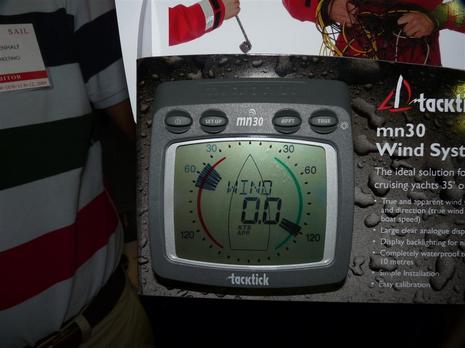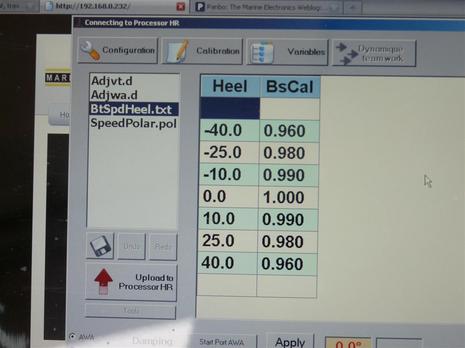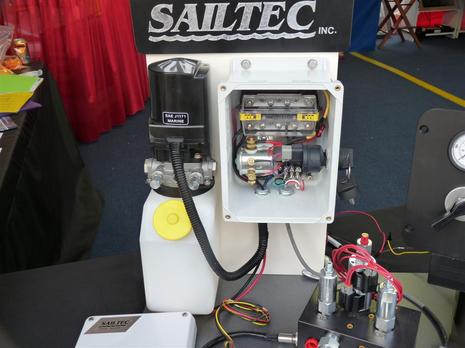Cruising with Dan in Annapolis
My family and I took a road trip to the Annapolis Boat show this weekend, where I took up a challenge from Ben to write on some products I find, and do so with a conservation of words (rather than my normal verbose style). Disclaimer: These are not my normal on the water reviews, everything appearing below has not been evaluated or researched by your humble correspondent in the slightest bit!
As with most of this show, new news was hard to come by. TackTick was no exception. The picture above is of the 12volt (rather than solar) model of their wind display. At a lower cost than solar it otherwise minimizes wiring using RF to communicate with transducers. The real news is that a reworked U.S. dealer distribution network is in place, future transducer products are under development, a product similiar to the T033/mn30 above is on the way for depth and speed, and in the “distant future” we can expect a Suunto watch (Suunto acquired Tack Tick) that can similarly display wireless transducer information. Also on display were various products submerged, and a new Suunto boat compass, a direct result of the merger.
ICOM’s booth takes water immersion demonstrations up a notch from TackTick, showcasing their products in moving water. The handheld above is the closest ICOM has to a new product on display in Annapolis. The IC-M36 has a feature in which the microphone and speaker volume automatically adjusts in relation to nearby ambient noise (engine noise, breaking surf, etc.) so your conversations are clearer. I see this as useful for setting the volume as low as possible avoiding my daughter complaining about my monitoring 16 while underway, which disturbs her music. After a little pumping, I learned ICOM has a finished product into the FCC with a full feature AIS B transceiver capability. Don’t expect it soon, they are on their second submission already and complained the FCC is “holding their product up.” I understand a USA release is over a year away (it’s already for sale in Europe). Beware, when it comes out this product will be between the M504 and enormous (8.6″ x 4.3″) M604 in size, far too large to fit into the existing foot print many of us have for our ship radio’s.
Also absent any new product announcements was NKE, which pointed out they didn’t need any to maintain their technology lead over competitors with their Regatta Processor. During an hour long visit I learned quite a lot from Bob Congdon (bobc), a repeated commenter / challenger of my product reviews here on Panbo. Bob filled me in on numerous benefits of NKE’s offerings and his point of view on why I shouldn’t be so impressed with the accuracy of products I have been reviewing. For example, the Regatta Processor can take the output of a paddlewheel or ultrasonic speed transducer (like the one I wrote about here last week) and correct for various types of error most instrument systems don’t offer calibration settings for. Pictured above are configuration settings to correct for boat speed at different angles of heel, as much as 4% of error in this example for a boat heeled 40 degrees. A correct boat speed also significantly improves true wind calculations.
At the Raymarine booth I headed straight for the E-Series Widescreen Ben wrote about here. My first use was to investigate if a keyboard would appear on the hybrid touch interface for naming waypoints (a fair guess that turned out correct). Next I checked out the funny control in the bottom right corner. The outside black ring on the control rotates to function like the thumb knob on the original e-series, the middle silver surface of the control functions like a joystick to move the cursor (useful for fine tuning after you finger touched a map location), while the center is an OK button function. Well done! Forgive my enthusiasm over this small point, but rotary controls feel natural to me and just like I desire them on my home stereo components, it’s great that it made it into the layout of the new e-series.
While it was slim pickings for new tech at this show, I did come across a just released product that has believable claims of being smaller, lighter (4x reduction), cheaper (by a factor of 5). I had a little difficulty understanding from SAILTEC why that matters, but finally got it. Can you guess what this new product does and its potential use on large sail or power boat?


















I had a good idea what the SAILTEC product was for until you mentioned “power boat”…
I suspect it is a compact hydraulic pump. Use it to lift a keel or centerboard on a sailboat, or to power a davit or open a large hatch on a powerboat.
Going to stop by their booth Thursday, in the rain. -Doug
Gary has the correct answer !
In the picture above is the Sailtec Power Pack consisting of a motor, pump, with oil reservoir and electric control that can activate hydraulic cylinders for sail boat rig tension, keels, hatches, transom doors or swim platforms, with application of course for the last three on power boats. Included in the picture is a version with zero leak valves capable of powering multiple functions at the touch of a button for single and double acting cylinders up to 3000 psi with .33 gal/min flow.
This small, compact and versatile motor and pump provides push button control of cylinders and eliminates the need for an engine driven pump, and as a package can be located where it is used. The engine driven alternative is 4x in weight and 5x in cost according to Bob Brehm, owner of Sailtec.
I suspect most of us would rather have our fingers directly on the controls and watch the gauges of a product that can generate 3000 psi, but I would imagine much of what would be needed to adapt this to NMEA-2000 is available from Maretron or other�s, yes ?
Dan: In fact there is no NMEA 2000 PGN for hydraulics, so I don’t see how — even if the Sailtec provided some kind of sensor output — you would transmit the PSI data in a format readable by an arbitrary (i.e., non-proprietary) NMEA 2000-capable display.
I have been saying for a long time that NMEA 2000 should provide PGNs for “typical” analog sensor data, like the 4-20 mA outputs common on commercial HVAC equipment, or a voltage follower. Calibration (limits, curves) would be handled on the display side.
This would allow for connection to a huge range of existing equipment. For example, the ultrasonic fluid-flow sensors that a few trawler owners have put in to monitor raw water flow could be hooked directly into a standard net. Today you need to use custom hardware/software to get such units onto an integrated boat monitoring system. Same, I would imagine, would apply to pressure monitors on hydraulic units like the Sailtec.
Rant complete.
A recent Tacktick press release confirms they will add depth, speed, and combo depth/speed instruments to their non-solar powered “entry-level range”. Also a teaser about a retro-fitting option for Airmar transducers. Let’s hope it’s a one-box solution, rather than the current hull transmitter/NMEA interface offering!
http://www.tacktick.com/files/Tacktick%20launch%20entry%20level%20electronics%20range%20at%20Mets%202009.pdf
Dan didn’t mention seeing this at the show, probably because it wasn’t there, it’s not a boating product and doesn’t even cost one Boat Unit.
http://www.withings.com/en/
“The WiFi Body Scale”
This is pretty cool even if most people would not want to get one for Christmas. But a transducer which sends data via WiFi, complete with an iPhone App, for $160 — nice! I can think of several transducers on my boat I would like to see WiFi connections to. While I wait for N2K to get real.